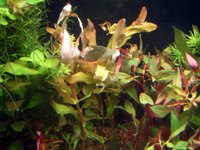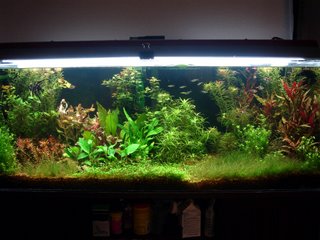New plant arrivals
- pH:
- Temp:
- KH:
- GH:
- NH4:
- NO2:
- NO3:
- PO4: 1.5
- Iron:
- Dosing:
- NO3:PO4 Cumulative Dosing Ratio:
Notes:
I recieved an order of plants from AquariumPlants.com: Rotala magenta, Ammania senegalensis, Ludwigia peruensis, and some more Anubias barteri var. nana.
I had placed an order with them a month ago, because I really wanted some Ludwigia peruensis, but after a week of not hearing from them, I called them and found out that they were out of stock (contrary to what their website said). They said it would come in the next week. I checked the next week, and the week after that, etc. and it still hadn't come in. I finally called Monday (a month later) to check and cancel the order, but the peruensis had finally come in (though they never bothered to ship out my long-standing order). I redid the order, and they promptly shipped it out the next day. The plants came in today in relatively good condition.
 The leaves on the bottom half of the Rotala magenta were melted away. They are probably somewhat fragile shippers. I planted the stems individually, about an inch apart from each other.
The leaves on the bottom half of the Rotala magenta were melted away. They are probably somewhat fragile shippers. I planted the stems individually, about an inch apart from each other. The Ammania senegalensis (middle of picture) seems to have been grown emmersed, there were flower buds growing off the stems, and the leaves are very broad, unlike the narrow down-turned leaves you see in pictures.
The Ammania senegalensis (middle of picture) seems to have been grown emmersed, there were flower buds growing off the stems, and the leaves are very broad, unlike the narrow down-turned leaves you see in pictures.The leaves of the Ludwigia peruensis (right side of picture) were more green than the expected purple (emmersed form?), but hopefully, they will turn that nice deep purple in my tank.
I'm not expecting all the new plants to survive, but I really wanted to try out these red plants. The Rotala magenta will probably be the most difficult plant to get to flourish, followed by the Ammania senegalensis, then the Ludwigia peruensis.
 I uprooted about half of the stargrass, and moved the rocks upon which the java fern and anubias nana were sitting upon to where the stargrass had been. I wrapped weights around the new nana to make them sink, and rested them on top of the rocks. Where I could, I buried part of the roots into the gravel.
I uprooted about half of the stargrass, and moved the rocks upon which the java fern and anubias nana were sitting upon to where the stargrass had been. I wrapped weights around the new nana to make them sink, and rested them on top of the rocks. Where I could, I buried part of the roots into the gravel.Since I did a lot of gravel stirring/uprooting, I really should have changed the water, but I was feeling lazy and decided to just run the diatom filter instead, and change the water on the weekend. Even the diatom filter is a hassle to run because of the DE powder and charging required. I had ordered a UV sterilizer (18 watt Turbo Twist), and when I receive it, I will try it out to see if I like the sterilizer or the diatom filter better, and return the other unit. The sterilizer should be more convenient, because it will be permanently plumbed in, so all I would have to do is to turn on the switch. The sterilizer is more expensive, though, and the bulb replacement is also very expensive.



0 Comments:
Post a Comment
<< Home